Primary election
In the United States, a primary election is an internal party election where members and party sympathizers theoretically choose candidates to be on a general election ballot. The system is modeled after the Electoral College; the voter is not actually voting for a candidate but a slate of electors or delegates who then advance to county, district, state, and national party conventions to choose party nominees. Primary elections were a progressive reform intended to let the people decide on party nominees for general election candidates, versus the old-fashioned method of party bosses in smoke-filled rooms selecting them.
| A guide to U.S. Politics |
| Hail to the Chief? |
| Persons of interest |
|
v - t - e |
Technically, some states hold primary ballot elections while others bring the advanced level of delegate selection down to the precinct level and are known as caucuses. Caucuses are a direct and personal method of selecting delegates, any voting age citizen can be nominated or nominate themselves as candidate for delegate to the upcoming local party convention and is voted upon right then and there[note 1]. Primaries and caucuses are regulated by state governments, although the actual delegate selection rules are made by the parties and may differ in the same state.
In practice, balloting and caucuses function largely identically, except that most caucuses don't allow absentee voting. In discussions it is common to lump primary elections and caucuses together under the term "primaries". While national party committees issue guidelines on how state parties should conduct their nominating process[note 2], state parties have leeway in setting procedures based upon state law and traditions.
There are several types of primary. In a closed primary, only active party registrants can vote for a party's candidate. In an open primary, anyone can cast a vote to select a particular party's nominee[1]. Open and closed primaries can be either binding or non-binding. A binding primary binds the delegates to the voters' choice. A non–binding primary is a “beauty contest” or a public opinion survey that party delegates are free to ignore.
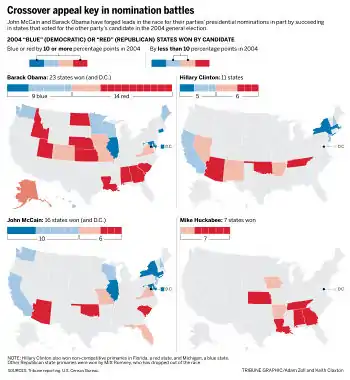
American and British systems contrasted
Unlike the British system for picking candidates for the position of head of government, the present day primaries generally by-pass party bosses (with the exception of Superdelegates) in favor of voter input. In Britain, candidates for Prime Minister are chosen by a party caucus of sitting Members of Parliament; in the United States they are chosen through the primary, caucus, and convention system. British parties have adopted an American-style televised convention system in recent decades replete with all the pomp and circumstance afforded American presidential nominees. The Democratic party's Superdelegates somewhat mirror the British system where members elected to the House of Commons have an automatic role to play in choosing a nominee for the country's Chief Executive. The primary system was originally designed because of American's distrust of party leaders[2], but with modern registration requirements by party, organized party leadership has effectively regained control of the nomination process[3].
Suggestions for a national primary
It has been suggested that a single national presidential primary would be better than the current state-by-state system.[4] With states holding primaries on different days over the course of months, voters with later primaries feel excluded as many candidates have dropped out by that point. An understanding of what the primary process is sheds some light on the inherent difficulties of a federal, national primary.
Primaries are private, party elections held in public buildings and voting places conducted by party officials.[5] Unlike a general election, where votes are tabulated by the County Clerk and certified by the Secretary of State, the parties themselves oversee the election and results. It is, after all, not a vote for a specific candidate, rather a vote for a party delegate to represent the voter at a nominating convention. Super Tuesday as of now is the closest thing to a national primary.
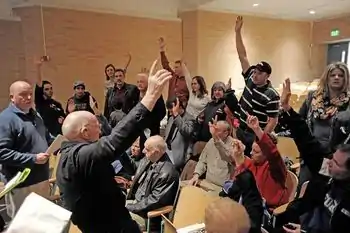
The McGovern-Fraser Commission (see below) after the 1968 Democratic Convention fiasco considered a national primary but dismissed the idea. Rep. Donald Fraser of Minnesota who co-chaired the Commission remained opposed. Minnesota is a caucus state, and Fraser liked the idea of citizen involvement. In a precinct caucus, people meet for hours and discuss candidates and issues before a vote is taken. Unlike polling stations in a general election, candidates and their campaigns can be very much involved on-site where there is much electioneering[note 3] going on. Unlike a ballot election, many voters show up at a caucus not predisposed to any candidate, idea, or issue and are willing to listen and be persuaded by arguments before casting a vote.
Fundamentally, the people of the United States do not, nor ever have, elected the President. The states do. Given that the parties themselves function under different rules of delegate selection, and the 50 states (plus territories) have different ways of conducting elections, the states are unlikely to give up the limited power they have.
The movement toward Saturday and early voting, which some states do not have, complicates things further. Polling places in small towns and rural areas often traditionally are staffed with volunteers on election day, and an advance voting period which would demand unpaid volunteers donate three weeks of their time rather than a single day, and the cost, may be unfair compared to larger populated, more affluent states and municipalities.
Ultimately, if such a thing as a national primary existed, candidates would have to focus on large states in play, and smaller states like Iowa or New Hampshire would feel forgotten, left out, and neglected, particularly given the added cost burden of early voting, and all factors into how the primary system evolved. The staggered process now over a 90-day window gives enough people around the country enough time to see and hear a candidate up close during the primary season. But he/she is not running for your vote, he/she is running for your delegate's vote.
Binding vs non-binding
In a binding primary, the decision of the voters is binding on the delegates selected to represent their choice at the national convention.
A non-binding primary is not really an election at all in the common legal sense of the word. Nor do the "participants" have the rights of voters. Rather than "voters casting a ballot", "participants express a presidential preference" which is non-binding on the delegates who are eventually selected in closed party caucuses. "Participants' preference" are merely advisory. It is no more than a convoluted public opinion survey for party insiders that requires "voter" registration and held to a certain extent at public expense.
Crossover voting
According to FairVote[6],
open primaries can lead to more centrist candidates being selected. As members of one party may cross over to vote in the other party's primary, they often vote for the candidate they consider least objectionable. Thus, Democrats voting in Republican primaries would vote for the most moderate Republican candidate and vice versa.
The same phenomenon however, can occur in a closed primary as well. But a little duplicity is often involved.
Shenanigans
Open primaries can lend themselves to abuse. Supporters of unchallenged incumbents are free to "cross over" and vote for the weakest, most fringe lunatic appearing on the ballot on the other side;[7] this is called "raiding" in political science. This results in eliminating a popular or serious challenger, and having an embarrassing idiot represent the opposition in a general election. To defeat outside disruption of a party's selection process, some state party organizations allow unbound delegates: delegates who are not bound to reflect the will of the people who voted in a party election. Open primary laws are generally sold to the public as a means to overcome voter apathy and encourage non-aligned independents to participate.
A closed primary has a party registration requirement which is not necessarily a deterrent to partisan shenanigans. A long-term popular incumbent may typically have no primary challenger for years or even decades. Party loyalists and operatives therefore have no need to register in their home party - a general election does not require any voter to be identified by party. Partisan loyalists are free to register on the opposing party rolls to sow disruption and participate in the selection of a weak opponent for a general election. And these sophisticated party activists deem it their civic duty to influence the outcome, rather than throw away a vote on their own primary candidate running unopposed.
Crossover registration and voting can happen at every level: city council, mayor, county commissioner, and on up. This stuff is always the subject of legal challenges, hence hybrids have evolved as the result of lawsuits and legislative compromise: semi-closed, semi-open, blanket, and top two. Needless to say, the system is still evolving.
Proportional allocation vs winner-take-all
Under rules for presidential nominating conventions in recent years, Democrats use proportional allocation of elected delegates and Republicans winner-take-all where state law allows. There are drawbacks to both methods.
Proportional allocation awards elected delegates according to the percentage of the vote for non-Superdelegates.[8] If Candidate A receives 60% and Candidate B gets 40%, the Candidate A's net gain is only 20% of the elected delegates and lessens a state's overall impact at the national convention (40% of the losers cancel out 40% of the winners in the same party). While this method appears "democratic", it is further diluted by unelected "Superdelegates", which constitute about one-sixth of convention delegates and exercise veto power over the people's choice.[9] This system seems unproblematic in a narrow field of only two candidates where it's a certainty one will receive a majority.
One criticism of the proportional representation method is that it keeps losers in the field long past their "sell by" date, such as Jesse Jackson in 1984, Hillary Clinton in 2008, or Bernie Sanders in 2016[10].
Winner-take-all harkens back to how the vast majority of states allocate electors to the Electoral College and provisions of the Twelfth Amendment[note 4]. In this scenario, it's not uncommon for a victor in a three-way contest with a plurality

Some state parties have a ‘winner-take-more’ or ‘winner-take-most’ rule, based upon the counter-reform movement of the 1980s of awarding ‘bonus delegates’ to a candidate who carries a majority in a Congressional district. A plurality in a district would simply divvy up the minimum number allocated to each district.
Alternatively to a three-way split in primary elections below the office of president, some states have a top-two runoff primary, giving crossover voters a second shot at knocking off their prime target.
Nominating conventions
A caucus is the procedure by which a local party officially chooses the person they will support in an upcoming election.
Delegates selected in primary elections advance to county conventions (in caucus states, caucuses at the precinct level select delegates to the county convention). All these advanced levels use the caucus method[11]. A county convention then selects delegates to the district[note 5] convention. A district convention selects delegates to the state convention; the state convention selects delegates to a national convention.
Presidential nominating conventions can be either opened or closed. At a closed convention, which has been the norm in the television age, the issue has been decided before the delegates arrive, the nominee is assured a First Ballot victory, and the convention is staged as a pre-General Election pep rally. First Ballot wins have been considered crucial since 1952 and the television age as a display of party unity. The party which displays disunity, like the GOP in 1964, 1976, 1992 and Democrats in 1968, 1972, 1980, 1984, usually looses. Open conventions can be quite messy and divisive, evoking hard feelings and lingering resentments.
Some history
The caucus method is as old as the Republic. In olden days, prior to the Civil Service Reform Act of 1883
At the local level, a mayor could award a top delegate whip[note 8] or organizer with the job of Police Chief, and loyal delegates as beat cops to carry out the party platform or harass opponents. The spoils system was rife with corruption and cronyism. When voters rebelled and elected the opposition, everyone in the political machine
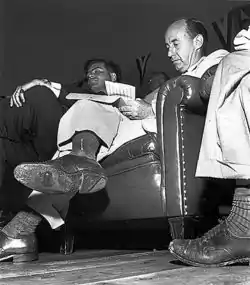
The movement toward primary elections began as a rage against the political machine. Fighting Bob LaFollette
Warren Harding, the proverbial "smoke-filled room" candidate, entered the 1920 GOP convention with 7% of the delegates in a field of 12 and accumulated the requisite number on the 10th ballot. The 1924 Democratic Convention still holds the record for stalemate and indecision with 103 ballots[note 9][note 10]. The Democrats eliminated the two-thirds nominating rule in 1936 because it produced seven multi-ballot conventions in the previous 100 years[14]. The unknown Wendell Wilkie in 1940 was anointed sacrificial lamb on the 10th ballot to run against the popular President Franklin Roosevelt, beating out several prominent GOP national figures such as Thomas Dewey, Robert Taft, Harold Stassen, Arthur Vandenberg and Herbert Hoover. And in 1952, Dwight Eisenhower, whom Democrats claimed Jesus Christ couldn't beat[15], was nominated amidst accusations of "delegate stealing".
After the reform movement of the 1970s and counter-reform movement of the early 1980s, in some states a voters choice became a “nonbinding advisory presidential preference” that “shall not be considered a step in the delegate selection process”[note 11]. In other words, a return to the closed caucus system after people expressed a "preference" in a non-binding “beauty contest”[note 12].
Fitting conventions to TV
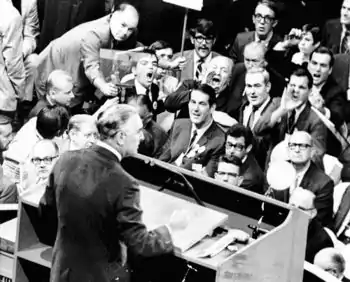
The television age ushered in a string of "closed conventions" where the party's dirty linen is hidden behind the backstairs. No convention in either party has gone beyond the first ballot since 1952, although there have been some pre-balloting platform, rules, credential committee and floor fights. A First Ballot win has been considered crucial as a display of unity. The party with disunity such as the GOP in 1964, 1976 & 1992 or the Democrats in 1968, 1972, 1980 & 1984, usually looses.
After the chaos of the 1968 Democratic National Convention
Sen. George McGovern, a leading member, wanted to "open up" the process of delegate selection and strip figures like Chicago Mayor Richard J. Daley
As McGovern basically wrote the rules for 1972, he of course triumphed on the first ballot, but his victory was followed by a lopsided loss to Richard Nixon in the general election[note 18].
So powerful was the leadership vacuum left by the assassination of President John F. Kennedy and disappointment with Lyndon Johnson, Hubert Humphrey and George McGovern, in 1976 Jimmy Carter ran second to "Uncommitted” in the Iowa caucuses and a follow-up win of 29% to 23% in New Hampshire. But the media made such a fuss about the “victor” throughout the expanded primary schedule Carter rode the media attention momentum all the way to the White House.
The last challenges to the closed convention
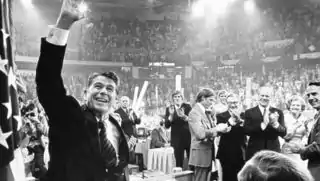
The last challenges to the "primaries decide the nominee; the Convention is only a rubber stamp" paradigm came in 1976, 1980, and 1984 convention cycles.
Reagan challenged the incumbent Gerald Ford[note 19] in 1976 over discredited New Deal-era economic theories, like wage and price controls which Nixon used and Ford supported[note 20]. Already holding the key California and Texas delegations, Reagan openly courted[note 21] the unbound Pennsylvania delegation promising to put liberal RINO Sen. Richard Schweiker on the ticket, but the idea failed.
In 1980 Sen. Ted Kennedy, whose brother was murdered just 6 weeks before the 1968 convention
In 1984 longtime party mechanic Walter Mondale
Reform and counter-reform attempts
In 2009 the respected Brookings Institute
In all of the recent presidential election cycles, the nomination process has generated controversy. Almost without exception, the controversy has been in the Democratic Party, which took the lead in reforming its nomination process in the 1970s. (p.1)
What reforms the Republicans have instituted have followed the pattern laid out by Democrats, but not always.
...the Republicans’ delegate selection processes evolved in tandem with reforms in the Democratic Party. Partly because many reform-minded Republicans also favored primaries...The Republicans, like the Democrats, also moved to processes that encouraged broader participation in those states that had closed party committee or caucus systems. The nationalization of candidate campaigns, movement to less politically seasoned delegates, and front-loading have also been similar for the two parties.
There are also important differences between the parties. Republican national party rules do not impose as many restrictions on state delegate selection processes as the Democrats’ post-1968 rules. Republicans never banned winner-take-all systems that facilitated the accumulation of delegates by early front-runners for the nomination; they never adopted a proportionality rule; they never adopted quotas for demographic groups; they never reserved seats for members of Congress; and they never imposed a national threshold for acquiring delegates in caucuses or primaries...(pp.8-9)
McGovern-Fraser Commission
McGovern was critical of the insider establishment’s way of choosing a nominee and wanted to switch over to primaries. Donald Fraser was a lieutenant in the Humphrey & Mondale Democratic Farmer-Labor (DFL) machine which dominated Minnesota where caucuses are popular. So a compromise was sought. The general feeling was that party insiders such as Mayor Daley and Southern Democrat bosses controlled too much power and through state party caucuses and conventions were able to impose their candidates on a national convention.
The commission recommended bringing more youth, women, and minorities into the delegate selection process and the party apparatus which then stacked the deck in favor of McGovern with New Left activists in 1972. It also recommended parties use their influence in State Legislatures to push for a more open process, which in many states meant abandoning the local caucus and using direct primary ballot elections.
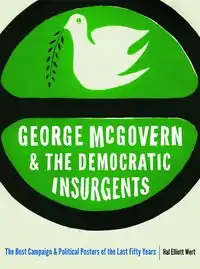
The McGovern-Fraser Commission (known as the "reform movement") required state parties to develop written rules and post uniform statewide notification of the date, time, and locations of precinct caucus meetings or party primary elections. There was a common practice in some Southern states, Mississippi for example, all-white local party bosses held meetings in obscure locations so that black majorities in a county or district were unaware of the time and place of a vital party election event. Although many provisions brought about by the commission were undone in the early 1980s, several key provisions have remained, and impacted the Republican party’s rules as well. Prior to McGovern-Fraser, several states had no written guidelines governing party conventions, caucuses, and the delegate selection process at each level, and were based mostly on local tradition, which often meant cronyism and the boss’s rule.
Another issue the commission dealt with was so-called “front-loading” the process in the newly expanded primary election schedule. Traditionally a candidate mapped a strategy as to which primaries they would enter, not so much to win delegates, rather an important test to prove viability to party bosses controlling large delegations in other states. John Kennedy’s West Virginia win was intended to prove Kennedy’s Catholicism was not an impediment in a predominantly Protestant state. Under the new system, a candidate needed to start early and compete in all primaries and garner free media attention.
Under McGovern-Fraser, new blood could ride the fast-track to party power. Among them were Gary Hart
Despite McGovern’s colossal electoral defeat in 1972 and ostracism from the party establishment, McGovern’s legacy as a reformer in the selection and nominating process is secure with an enduring affect on both parties.
Mikulski Commission
After the 1972 election, Congresswoman Barbara Mikulski

replaced the demographic quotas of 1972 with affirmative action requirements to increase participation by women, blacks and other minorities. (However, this specific plan had the OPPOSITE effect, decreasing the proportion of women from 38% in 1972 to 36% in 1976. The proportion of blacks declined from 15% in 1972 to 7% in 1976. After 1976, quotas for women delegates were reimposed.) PROPORTIONAL REPRESENTATION, the distribution of delegates among candidates to reflect their share of the primary or caucus vote, was mandated by party rules[26].
The Mikulski Commission went further than McGovern-Fraser, proposing to bind rules on state parties which would restrict delegate selection in primaries or caucuses to "Democratic voters only who publicly declare their party preference and have that preference publicly recorded" (Rule 2A). This required a party registration process before being able to vote in a Democratic primary. The new rule put pressure on parties to close their primaries to outside participation and brought about "same-day registration"[27] in states with open primaries mandated by state law. The DNC incorporated these recommendations into the Delegate Selection Rules for the 1976 Convention. A temporary exemption where state legislatures had no party identification requirement to participate in a primary election was included. Opponents and dissenters felt this new rule violated the integrity of the secret ballot at public polling stations.
Wikipedia summarizes the imposition the Mikulski Commission placed upon non-partisan
a public declaration in front of the election judges is made and a party-specific ballot given to the voter to cast.
In other words, a voter who wished to vote for a Democrat for President and a Republican for Senate, would be denied that right.
Winograd Commission
In 1975 the Democratic party asked Morley Winograd of the Michigan Democratic party to chair yet another commission that was particularly concerned about crossover voting. The commission focused on Wisconsin's unique direct open primary which had a considerable body of law behind it since inception in 1905, and was the model the McGovern-Fraser reforms used to expand primaries to 25 states. The commission sought to limit participation in the candidate selection process by outlawing open primaries it felt interfered with the national party’s associational rights[note 23].
As a result of the commission, the Democratic National Party sued the State of Wisconsin over a 1949 law which required that party delegates pledge to vote at their conventions in accord with open primary results[29]. The U.S. Supreme Court overturned a ruling Wisconsin Democrats won over the National Democratic party in the Wisconsin Supreme Court. Wisconsin Democrats were forced to abandon their 80 year old direct primary election because it conflicted with the national party's 14th Amendment associational rights – the requirement participants in a primary make a public declaration of affiliation as revised by the Mikulski and Winograd Commissions. State party bosses had to amend the rules for the 1984 primary to make the people’s vote a non-binding "beauty contest". A “presidential primary election” became a “presidential preference primary”, and a “voter” became a “participant” who expressed a non-binding “presidential preference” rather than a vote. National delegates were again selected in closed caucuses, the same system that existed before the LaFollette reforms.
Hunt Commission
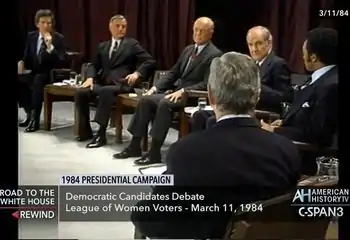
After Ted Kennedy's challenge and President Carter's loss, Democrats met again for the fourth time in twelve years to re-write nominating and convention rules.[30] Anticipating a two-way contest in 1984 between Sen. Kennedy and former Vice President Mondale[note 24], the original point of contention was over bound delegates. Sen. Kennedy wanted to loosen the rules, while the Mondale machine wanted a candidate to go so far as being able to replace a "disloyal delegate"[31].
The Mondale machine, supported by Chairman Jim Hunt and labor leaders, more importantly wanted to do something about outsiders and New Left “extremists”[note 25][35] they felt had taken over the party. They wanted to do away with portions of the McGovern-Fraser compromise that had frozen elected government office holders out of the nomination process[36] and paved the way for an "insurgent candidate"[note 26]. The new rules the Democratic National Committee (DNC) adopted didn't just allow or encourage incumbents to return, it guaranteed elected officials seats outside the regular delegate selection process. The Kennedy faction wanted to pare down the number of reserved seats from 30% (roughly 800) of all delegates to 14%[37]. Susan Estrich
The Hunt Commission (also known as the "counter-reform movement") scrapped the proportional allocation rules from the 1970s[note 28] in favor of winner-take-all which had the unintended affect in 1984 of allowing Gary Hart, a challenger for whom the rules were not written, to rack up big delegate wins in late primary states[40].
When Sen. Kennedy decided not to run in 1984, two insurgent candidates appeared, McGovern's 1972 "New Democrat" campaign manager Sen. Gary Hart, and Jesse Jackson who was to be the first African-American to win states in a major party primary election for president[note 29]. But the rules were written for a two-way contest between establishment insiders, not the three-way slugfest between uppity baby boomers, blacks, and the party Old Guard it came to be.
Modern era
Talk of an open or "brokered" convention emerged again in the 2016 cycle, this time on both sides, the "Stop Trump" movement among conservatives on the GOP side and the stacked deck of Superdelegates for Clinton in states Bernie Sanders won on the Democratic side[42].
Conventions are less about issues and ideas and more about people and career paths[note 30]. Issues are treated as marketing strategies which need a consensus for use in local races. National conventions in the television age have become entertainment venues and a display of party unity where internal differences are closed for debate[note 31]. Open or "contested" conventions hold to Bismarck's axiom about politicking, "making law is like making sausage, if you don't like how it's done, don't watch."
Bound vs unbound delegates
Bound delegates elected in a Presidential nominating contest are committed by party rules to reflect the will of the voters in the snapshot poll conducted during primaries and caucuses. Unbound delegates are empowered to use their own judgment as a representative of the people who voted in a party election -- with the exception of the “unpledged” Superdelegate who can vote anyway they please based upon what they feel is in the best interests of the party, or to a candidate they personally are bound after accepting campaign contributions from the candidate.
In the Democrat's current proportional allocation system, all elected delegates (84% of the total) are "pledged" (note, not "bound") to the candidate they are allocated to. The unelected Superdelegates, who constitute 16% of the total, are not bound.
In a three-way contest, such as the Democrats experienced in 1984 it would be possible no candidate would have a majority (50% + 1) on the first round. Unbound delegates are the only ones who can break the deadlock. In an open convention if we were ever to see one again, the rules would allow bound delegates to be unbound on successive ballots. Machine politics again come into play with great pressure put upon delegations to present the entire slate for maximum leverage to one or other candidate whom party bosses favor. There is more at stake than just delivering a delegation to a candidate. In certain key "toss up" or "in play" states, an enthused and united party organization hopes to deliver the entire state in the General Election, where the perks and incentives get higher. The General Election is a winner-take-all scenario.
At-large and Superdelegates
Republican party rules allow for 3 unelected At-Large voting delegates from all the states and territories, 168 in number. These are high ranking state party apparatchiks. They do not represent a district, they represent the state party as a whole[note 32].
The Democratic party likewise has 719 [note 33] unelected Superdelegates, current and former office holders, donors, and big shots. The issue is controversial. There are pros and cons to this system.
- Pros
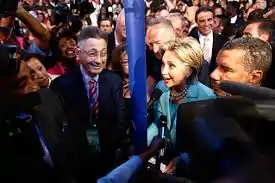
- Reward for high office seekers to have influence and impact at the national level.
- Assist high level office holders in fundraising to maintain incumbency.
- Disallows outsiders and "insurgent candidates" from hijacking the presidential nominating process.
- A built in “stabilizer” against mob rule and the emotional excesses of the people.
- Cons
- Elitist, non-democratic, and undemocratic in nature on the face of it.
- Makes a rebellion by grassroots activists who feel neglected or betrayed difficult.
- Insures the survival and control of an establishment political class.
- Potential path for overt corruption to influence the political process
Republican At-Large party chairpersons function as a whip to carry the message from state party donors and bigwigs whom the state party favors. Democratic Superdelegates perform this same function for themselves, their donors, and as party trustees[43]. Both have the ability to use persuasion, incentives, and perks to influence unbound (or "unpledged" among Democrats, if any) delegates. As the saying goes, "Buying a government official is illegal, buying a party delegate is not."
On balance, it's not likely the Democrats will repeal the system given its success. No Democrat was elected to two terms since Franklin Roosevelt before the new rule. Since the Superdelegates, Democrats have twice elected 2 term presidents. What's more likely are minor tweaks for PR purposes given the negative publicity. Meanwhile, the Republicans again will be contemplating their own system as it looks at how the Democrats found a way to hold in check and defeat an "insurgent candidate" from hijacking the nomination, such as Donald Trump, who defies the party establishment and the traditional ideological principles the party stands for, which is the justification and model used to create Superdelegates[44].
1984 primaries and convention
In 1984 Gary Hart won 26 states and 1164 delegates
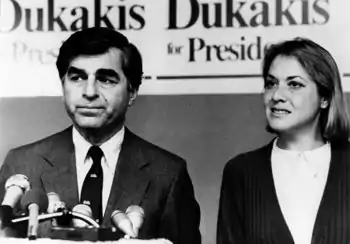
By convention time Hart was beating President Reagan by 10 points in national polls, but Mondale won nomination by capturing virtually all the Superdelegates[note 34]. Even at this late date more than 30 years later it is hard to ascertain just exactly how many Superdelegate votes there were at this cooked convention[note 35]. Multiple original sources put the figure between 550 and 800; The Nation magazine says "roughly 700" [46] and Salon says 550 [47]. Wikipedia is silent on the matter. Whatever the result, it is patently clear the Democratic establishment was not going to let anyone other than Walter Mondale win the nomination after Sen. Kennedy forfeited[48].
One state, Wisconsin[note 36] according to the "official" surviving record, voted twice in primaries and caucuses under the shameful antics Mondale's DNC machine perpetrated. Wisconsin had experience with primary elections for 80 years[49], but more than half the states in the nation had only 12 years after the McGovern-Fraser reforms to learn about the closed door shananigans that can occur in a primary election -- such as the ever changing nature of rules year to year, or being misled by state party officials, and not informed you were voting in a non-binding primary[50][51]. Voter’s franchise has been effectively usurped by party insiders and Superdelegates.
Under the rules then, Superdelegates were not supposed to "commit" to a candidate until the convention. Hart says he and his wife personally spoke with all of them to ask for their support, but virtually all were committed to Mondale for 2 years already[52].
After the Mondale-Hart debacle, another player who ran McGovern's Texas campaign, Bill Clinton, helped organize the Democratic Leadership Council (DLC). By 1992 the DLC had taken over the Democratic National Committee, but it failed to reform Mondale's rules of special privileges for party insiders. The DLC, made up originally of New Leftists, as "New Democrats" followed the view of old guard Democrats that the party had been hijacked by extremists, and the new Superdelegate structure could be used by a new generation of insiders to keep control. But the New Democrats went a step further: they sold out their leftist idealism for corporate greed.
2008 primaries and convention

Hillary Clinton who touted her role as a hands-on operator during the White House years, was at his side when Clinton raised mandatory sentencing guidelines which disproportionately sent Blacks to prison, giving the United States the highest incarceration rate in the world[53]. In 2008, the "inevitable" Hillary Clinton found herself facing an African-American challenger who parlayed every dime he made as a top Democratic fundraiser since his ascent as keynote speaker in 2004, to outbid Hillary's donations to Superdelegate's for their support[54].
President Bill Clinton made a special visit to the ailing Sen. Ted Kennedy to ask his blessing on his wife's candidacy. Kennedy's endorsement, as heir to the New Deal and Kennedy legacies, leader of the civil rights and liberal tradition as well as access to the New England Democratic donor base, was vital. Clinton said Obama would have been "carrying our bags and getting us coffee" a few years earlier[55]. Kennedy was so offended by Clinton's racist remark, he backed off and endorsed Obama[56][57].
Hillary Clinton's campaign team began spreading Islamophobic rumors that Obama was a Muslim schooled in a madrassa as a child in Indonesia[58][59].
While it looked like an open convention might have happened again, ultimately Hillary Clinton conceded even though she had won more popular votes
2016 primaries and convention
In Bernie Sanders' 25 years in Washington caucusing with the Democrats, he never once served as a Superdelegate -- not until he registered as a Democrat to seek the party's presidential nomination a few months earlier. Although he had voted for party leaders and was awarded preferential committee assignments, his absence as a Superdelegate earned him very little, if anything, from his Congressional colleagues for decades of loyalty on votes and bills. Their support overwhelmingly went to a one-term Senator, multi-millionaire, and effective fundraiser who swamped the delegates with cash donations for their own campaigns[60][61].
In New York, state law dictated a closed primary where voters had to publicly declare party affiliation. 5.3 million registered Democrats could vote for Sanders or Hillary Clinton and 2.6 million Republicans could vote for Donald Trump, John Kasich or Ted Cruz. But nearly 3 million non-affiliated independents and other party members were denied access and shut out of the process[62].
Regional coalitions
The choice of a Vice Presidential candidate historically has been based upon coalitions of state parties using a regional strategy for "balance", although in recent decades there have been instances of a movement away from this approach in place of using more widespread demographic or other factors. We will focus on the more illuminating regional party coalition approach first.
North - South coalitions
The first and more obvious regional coalition is the historical New England liberals with Southern Democrats replicated many times in many ways (winners in green, losers in brown):
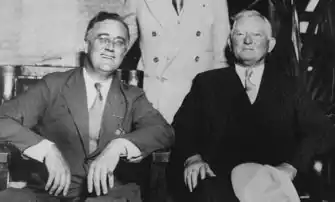
- 1932 - Franklin Roosevelt (New York)/John Nance Garner (Texas)
- 1936 - Franklin Roosevelt (New York)/John Nance Garner (Texas)
- 1960 - John Kennedy (Massachusetts)/Lyndon Johnson (Texas)
- 1988 - Michael Dukakis (Massachusetts)/Lloyd Bentsen (Texas)
- 2000 - Al Gore (Tennessee)/Joe Lieberman (Connecticut)
- 2004 - John Kerry (Massachusetts)/John Edwards (North Carolina)
Variations of this pattern are Midwestern liberals with Southern Democrats:
- 1952 - Adlai Stevenson (Illinois)/John Sparkman (Alabama)
- 1956 - Adlai Stevenson (Illinois)/Estes Kefauver (Tennessee)
- 1964 - Lyndon Johnson (Texas)/Hubert Humphrey (Minnesota)
- 1976 - Jimmy Carter (Georgia)/Walter Mondale (Minnesota)
- 1980 - Jimmy Carter (Georgia)/Walter Mondale (Minnesota)
- 2016 - Hillary Clinton (Illinois)/Tim Kaine (Virginia)[note 38]
East - West coalitions
Republicans have used more East - West coalitions (Note: The General Election success of the GOP in Ike, Nixon & Reagan's two terms, and Papa Bush's first term were all predicated on carrying California & Texas - 1/3 of all electoral votes; when Clinton won California in 1992, that was the end of a 40 year strategy. In 2016, Texas Senator Ted Cruz took the unusual step of naming Carly Fiorina of California as his VP choice 6 weeks ahead of the California primary in an attempt to re-build the CA-TX alliance)
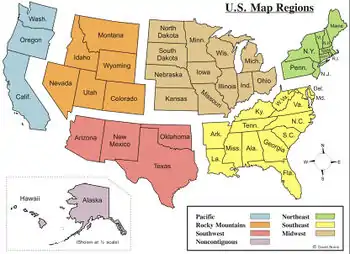
- 1948 - Thomas Dewey (New York)/Earl Warren (California)
- 1952 - Dwight Eisenhower (Pennsylvania)/Richard Nixon (California)
- 1956 - Dwight Eisenhower (Pennsylvania)/Richard Nixon (California)
- 1960 - Richard Nixon (California)/Henry Cabot Lodge (Massachusetts)
- 1964 - Barry Goldwater (Arizona)/Bill Miller (New York)
- 1968 - Richard Nixon (California)/Spiro Agnew (Maryland)
- 1972 - Richard Nixon (California)/Spiro Agnew (Maryland)
- 1980 - Ronald Reagan (California)/George H.W. Bush (Connecticut)[note 39]
- 1984 - Ronald Reagan (California)/George H.W. Bush (Connecticut)
Northern tier Yankee states
Unbalanced regional coalitions (basically Northern tier Yankee states, also known as Free Soil states in the pre-Civil war era), have a poor record:
- 1972 - George McGovern (Northern plains)/Sargent Shriver (East)
- 1976 - Gerald Ford (Midwest)/Bob Dole (Central plains)
- 1984 - Walter Mondale (Midwest)/Geraldine Ferraro (East)
- 1992 - Papa Bush (East)/Dan Quayle (Midwest)
- 1996 - Bob Dole (Central plains)/Jack Kemp (East)
- 2012 - Mitt Romney (East)/Paul Ryan (Midwest)
- 2016 - Donald Trump (East)/Mike "Disco inferno" Pence (Midwest)[note 40]
Demographics and other
A recent trend has been to ignore regional balance and focus on a wider demographic popular vote, or balance a ticket with a foreign policy guru, regardless of how many Electoral votes a running mate brings to the table. Ferraro and Palin were the first women from each party to run on a national ticket. Dan Quayle, Bill Clinton, and Al Gore represented "generational change", the first candidates born in the post-1945 World War II era. Obama was something of a novelty candidate representative of a demographic group that superficially is a fraction of women and baby boomers[note 41] and won anyway on an unbalanced regional ticket. Cheney and Biden were intended to make up for their bosses foreign policy inexperience.
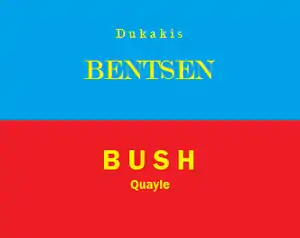
- 1984 - Walter Mondale (Midwest)/Geraldine Ferraro (East)
- 1988 - Papa Bush (East)/Dan Quayle (Midwest)
- 1992 - Bill Clinton (South)/Al Gore (South)
- 1996 - Bill Clinton (South)/Al Gore (South)[note 42]
- 2000 - George W. Bush (Southwest)/Dick Cheney (Mountain west)
- 2004 - George W. Bush (Southwest)/Dick Cheney (Mountain west)
- 2008 - John McCain (West)/Sarah Palin (Far Northwest)
- 2008 - Barack Obama (Midwest)/Joe Biden (East)
- 2012 - Barack Obama (Midwest)/Joe Biden (East)
One more aside on the choice of a VP. It has become increasingly the custom to defer to a party's nominee to have first choice, however no hard and fast rule mandates this. In the case of an outsider, the choice can be dictated to the nominee. Richard Nixon was imposed on Dwight Eisenhower by party bosses and brokers. Eisenhower was an outsider who made no party affiliation known til after his retirement from the military. Eisenhower never held elective office nor had familiarity with internal party mechanics, and was only too happy to defer the decision to others.
Backstair deals
Backstair deal cutting happens all the time at all levels, both leading up to a convention and at a convention itself. A popular insurgent challenger against an establishment choice can be bought off or urged to stand-down and wait their turn til next time in exchange for certain advantages. At the presidential level we've seen this in the cases of McGovern in 1968 & '72; Reagan in 1976 & '80; the Ted Kennedy & Mondale contest from 1980 to 1982 which never fully materialized; Gary Hart from 1984 to 1987 until he had a "misstep through a personal indiscretion"[63] . The nomination rotated back from the Minnesota machine to the other half of the Northern tier New Deal coalition, the Massachusetts machine. Susan Estrich, a dissenter on the DNC panel opposed to Superdelegates on the grounds they amounted to sex discrimination, was thrown a bone with the honorary distinction of being the first woman to manage a major party presidential candidate machine in 1988. Other deals were John McCain in 2000 & '08; Mitt Romney in 2008 & '12[note 43]; Hillary Clinton in 2008 & '16[note 44], or possibly Ted Cruz after 2016[64].
Campaign machines and warchests
The majority of delegates at a national convention typically are active in a candidate's campaign machine, specifically "down ballot" candidates. Money is the mother's milk of politics[note 45]. All candidates must attract donors and build a warchest for the continuing election cycle. Some candidates are lucky, mostly incumbents in so-called "safe seats" who attract big donors more than they need. These "unspent funds" can be used to build a machine - donated to other candidate's campaign organizations to bind loyalty.
For example, a popular candidate for Governor may need $5 million to run a statewide election. He/she raises $8 million in a campaign warchest. The candidate can then make significant contributions of the unspent balance to State House and Senate candidates, essentially buying the legislature he needs to pass his program[65][66].
In the case of unelected Superdelegates who hold public office, records show they tend to be recipients of large donations from Presidential candidates seeking nomination[67][68].
See also
Notes
- A caucus can devolve essentially into a cage match, where several candidates compete for a limited number of spots and are set in a room to battle tooth and claw over issues until a few victors emerge and advance to the next level. A precinct caucus is also known as a primary caucus.
- For example, after a series of disagreements and confrontations over many years with the national party, in 1972 Mississippi sent two delegations to the Democratic National Convention; the national party's Credentials Committee sent one home. National parties have the ability to "penalize" state parties that do not make efforts to reasonably follow national party guidelines.
- See for example WP's Iowa caucuses/Democratic Party process
File:Wikipedia's W.svg for more information on electioneering. - If the Electoral College were deadlocked, each state Congressional delegation is allowed one vote. A state with an equally divided delegation by party, say 10 members with 5 Democrats and 5 Republicans for instance, would caucus together (Republican and Democrat) and vote for one candidate, or the entire state forfeits its one vote by abstaining if the state's Congressional delegation is deadlocked.
- A district convention refers to a U.S. Congressional District; State governments do not have a "district" that corresponds to party or congressional districts. Democrats used to call these “loophole” conventions. Illinois still has "loophole" primaries. Some delegates are allocated by a voter’s presidential preference choice, other delegates are listed separately on the ballot and allocated for that Congressional district. It is theoretically possible for a voter to elect delegates backing two different candidates.
- The immediate impetus for ending patronage and introducing civil service reform was the assassination of President James Garfield by a disgruntled low level campaign worker who was by-passed and felt Garfield owed him a job.
- Vestiges of this system existed as late as the Truman administration in the "5 Percenter" investigations where the Mississippi Democratic Party was investigated for the sale of Postal jobs for a 5% commission.
- A Whip's job is to "whip" the delegates into line before the vote.
- Spawning Will Rogers oft repeated remark, "I'm not a member of any organized political party, I'm a Democrat."
- The Convention also failed to pass a plank in its platform condemning the Ku Klux Klan by a vote of 542.85 in favor to 546.15 opposed. Hence it is remembered as the 1924 Democratic "Klanbake" Convention.
- Rule 12D as drafted by the Winograd Commission. LaFollette claimed that with primary elections the "nominations of the party will not be the result of 'compromise' or impulse, or evil design--the 'barrel' (a reference to money in politics; see also here) and the machine--but the candidates of the majority, honestly and fairly nominated"[16]. The open primary of today, or cross-registration in a closed primary, "non-binding primaries", and the ability of office holders donating money to each other, defeats the basic reform ideas LaFollette instituted. Rather than bribing individual politicians, a corporation or individual can make large donations to an elected official at the top of the machine pyramid who then doles out the contributions to other elected officials and candidates to buy their loyalty.
A cynic would argue primaries only give a veneer of citizen involvement and participation. LaFollette addressed two problems: (1) overcoming immense voter cynicism and apathy in General Elections because of lousy choices between corrupt machine candidates, and (2) limiting the power of corrupt municipal and state party machines. The second objective had some success by "empowering the people" until elected machines found ways to disguise their activities; but LaFollette was successful enough in his first objective to the point where a naive public bought into the idea they had actually defeated corrupt local, state, and national party machines. - with delegates selected by demographic quotas and not by actual votes cast.
- A common tactic used by Mayor Daley in Chicago City Council meetings and echoed throughout the city in precinct caucuses and labor halls to shout down an opponent. Profanity of coarse is out of order, but in a raucous session, when an opponent with the floor said something critical, Daley would shout "He's a faker!" and the entire room would erupt with machine operatives shouting, "you faker!", or other derisive labels. Daley particularly felt betrayed, having stuffed the ballot box for the Kennedy's and robbing Richard Nixon of the presidency in 1960, to then be accused of "gestapo tactics", beating up and arresting hippies and war protesters. In the interim between conventions, hippies and New Left war protesters were invited into the party by the McGovern-Fraser Commission and formed McGovern's core constituents four years later. The commission gave sitting incumbents like Daley the boot.
- Humphrey gave a rousing speech at the 1948 convention
File:Wikipedia's W.svg considered to be the beginning of the modern civil rights movement[18]. The speech caused the Mississippi delegation and portions of others to walk out and form the Dixiecrat party fielding Strom Thurmond as its Presidential candidate. It was the beginning of a long career making Humphrey the face of liberalism, rivaled only by John Kennedy and Lyndon Johnson. - Tom Hayden, convicted on federal charges of crossing state lines to incite riot
File:Wikipedia's W.svg , served as a delegate to the 1992 convention. - After the assassination of Robert Kennedy who was a leading critic of President Johnson's war policy, Humphrey was regarded as a war hawk
File:Wikipedia's W.svg who would continue Johnson's Vietnam War policy. Johnson dropped out of the race due to growing unpopularity of himself and the war, and McGovern made himself heir of Bobby Kennedy's dovishFile:Wikipedia's W.svg stance. Closed machine caucuses in caucus states accumulated enough delegates for Humphrey to override primary voters in states without precinct caucuses. - Besides the Mississippi delegation, the Credentials Committee machine replaced Daley's contingent of the Illinois delegation with a group sent by Jesse Jackson[20].
- Nixon's Silent majority
File:Wikipedia's W.svg coalition (Republicans, George Wallace voters from 1968, and patriotic Democrats who voted for Johnson in 1964, Humphrey in 1968 and supported American efforts in the War in Vietnam), played a significant role at the grassroots level, i.e. crossover shenanigans, in propelling McGovern to the Democratic nomination. The Mikulski and Winograd Commissions later sought to deal with crossover voting in a Presidential primary.
Nixon's General Election popular vote margin remains the largest in U.S. history, surpassing the landslides of FDR, LBJ & Ike and only rivaled by George Washington's unanimous victory. - Donald Rumsfeld, Karl Rove and David Gergen served as Ford delegates; Dick Cheney and James Baker III
File:Wikipedia's W.svg rounded up the unbound delegates for Ford. - President Ford’s WIN campaign to fight inflation was largely the AARP in embryo, which tangled with Reagan later; while young people couldn’t find jobs as the cost of living skyrocketed, Ford mobilized an older generation sitting on their asses collecting Social Security to sing Irving Berlin
File:Wikipedia's W.svg songs and tough it out. It was generational warfareFile:Wikipedia's W.svg long before Gary Hart, Dan Quayle, Bill Clinton or Al Gore – the best and the brightestFile:Wikipedia's W.svg of baby boomerFile:Wikipedia's W.svg s – ever emerged on the national stage. - i.e. Reagan avoided the taint of the ‘smoke filled room’. Reagan and Schweicker met personally with the entire Pennsylvania delegation to lay out the request for their support. The idea was unique in the television age: a candidate publicly proposed a VP pick as part of a deal before any balloting. John Kasich, Phyllis Schlafly, Mark Levin, Jesse Helms, and Haley Barbour served as Reagan delegates.
- Kennedy was able to push an unresolved Rules Committee fight to a floor vote.
- The Winograd Commission found that in 1968, crossovers were 28% of voters in the Wisconsin Democratic primary. 48% of those who said they were Democrats voted for Sen. Eugene McCarthy
File:Wikipedia's W.svg , while 39% voted for President Johnson. A vote for Johnson, who dropped out just days before, was an expression of the "Uncommitted" stance which became increasingly popular among Democrats for the next decade. From the moment Johnson dropped out until Jimmy Carter's second place finish in the Iowa Caucus - which was a year after the Vietnam War ended, two years after Nixon's resignation, 4 years after McGovern's colossal defeat, and six years after Nixon put together the Silent Majority coalition, "uncommitted's" still ruled the Democratic party who were not happy with any of the party's leadership.
Of the crossovers, 70% voted for McCarthy while only 14% voted for Johnson. Participation of crossovers increased McCarthy's margin over Johnson by two and one-half times.
In 1972, crossovers amounted to 34% of voters. 51% of self-identified Democrats voted for McGovern, while only 7% voted for George Wallace. Of the crossovers, however, 33% voted for McGovern while 29% voted for Wallace. The study figures the Winograd Commission used indicated 2/3 of Wallace's support came from crossover voters and concluded with proportional allocation, "crossover voters will . . . alter the composition of national convention delegations." [28] - Bad blood existed between the Humphrey-Mondale and Kennedy machines going back to Humphrey's 1960 Presidential primary campaign
File:Wikipedia's W.svg . Humphrey later wrote of the Kennedy machine, "underneath the beautiful exterior there was an element of ruthlessness and toughness I had trouble either accepting or forgetting." - hippies and peaceniks of the 1960s. Jane Fonda
File:Wikipedia's W.svg and Tom HaydenFile:Wikipedia's W.svg are interesting case studies; by 1980 Fonda was calling herself a "small 'd' democrat"[32] advocating “industrial policy” and “economic democracy”[33] while Hayden was entering the ranks of the “establishment” electoral process through the California Democratic machine. Fonda’s terminology remarkably resembles views espoused by Bernie Sanders who also began a career in electoral politics outside the Establishment Democratic Party in the early 1980s. Fonda and Hayden became involved in the ‘save the whales’ and Greenpeace movement. By 1979 the Cambodian holocaustFile:Wikipedia's W.svg and refugee crisis was well under way, and a popular reaction against the “anti-establishment”File:Wikipedia's W.svg [34] New Left peace movement of the 1960s took hold in the United States. Bumper stickers with slogans such as “nuke the whales” became fashionable. - The original "insurgent candidate" the Hunt Commission referred to in coded language was George McGovern whom after his massive Electoral loss in 1972 was seen as anti-patriotic for his longstanding opposition to President Johnson's War which had the effect of dividing the country, and the party, and permanently tarnished Johnson and Humphrey's impressive civil rights records, painting these two true blue liberals for posterity as "war hawks".
George Wallace was considered a particularly unwelcome insurgent, considering he had won more states and Electors in 1968 than the party's own nominee in 1972. Wallace had sown disruption and division within the party in the 1964, 1972, and 1976 election cycles which had conflicted with the parties outreach aims culminating in the Voting Rights Act of 1965 and the affirmative action quotas of the McGovern-Fraser and Mikulski Commissions. Many Southern Democrats by this time already viewed themselves as persona non grata and moved to the Republicans, such as Texas Governor and presidential aspirant John ConnallyFile:Wikipedia's W.svg , and others.
Another “insurgent” was Mondale’s old boss, Jimmy Carter, who was first to recognize the new system of manipulating free television air time (and not Ronald Reagan as some believe) with early primary and caucus wins to pile up rapid delegate leads and soak up donor contributions to gain momentum. Carter had scarce contacts with old party bosses and soon buried competitors working under the old system.
It further should be noted, Lyndon LaRouche was considered by some as a viable candidate in 1980 & '84. While his ability to fundraise was impressive if not frightening to someFile:Wikipedia's W.svg , he never garnered more than 2% in any primary, won no delegates, nor had his name placed in nomination. LaRouche however would also fit the generic term "insurgent candidate" at that time, although his bluster never amounted to any real threat of hijacking the party. - Estrich and Dukakis are ranking members in the Massachusetts Kennedy machine which tried to resurrect the 1960 alliance and victory with Texas Democrats on the Dukakis/Bentsen ticket.
- Prior to proportional representation there was the “unit rule”, a delegation had to vote as a unit, now known as “winner-take-all”. McGovern-Fraser scraped the unit rule for affirmative action, or “proportional allocation”. Today’s supposed “unpledged” Superdelegates function as the local bosses whose cronies, that is, “pledged delegates”, earned their status working to elect Superdelegates to public office in previous elections. Together they function as a unit wherein the boss’s favorite carries the majority of delegates from a state.
- Susan Estrich's words were prophetic: the good old white boy network shot him down. See DISPARITY BETWEEN JACKSON'S VOTE AND DELEGATE COUNT VEXES PARTY, by DAVID E. ROSENBAUM, New York Times, May 20, 1984, below. Serious Black contenders just had to wait their turn a few more decades.
- 2016 GOP hopeful John Kasich for example, boasted of attending 10 Presidential nominating conventions, beginning as a Reagan delegate at the 1976 contested convention. From there he got himself elected to the State Senate, U.S. House, later Ohio party boss and Governor, and eventually Republican Presidential candidate and power broker.
- The 1992 Democratic Convention for example, is more remembered for its primetime Broadway musical and dance choreography than any speech given.
- The Republican National Committee (RNC) is basically modeled after the U.S. Senate. It consists of 100 Committeemen 2 each elected by State party conventions, similar to the way State Legislatures used to elect U.S. Senators prior to the 17th Amendment; At-Large delegates are the two RNC Committeemen and the State party Chairperson, all elected at the state convention.
- The number varies cycle to cycle based upon the number of Congressional seats, Governorships, and other offices the
NomenklaturaDemocratic party controls, and when vacancies occur during the 90 day window for selection or at the time the Credentials Committee convenes.File:Wikipedia's W.svg - and the odd thing is, most analysts and historians agree Mondale lost the General Election right there in his Acceptance Speech by vowing to raise American’s taxes.
- As of April 2016 Wikipedia's 1984 Democratic Primaries page does not even mention the term "Superdelegate" anywhere.
- The official record shows Hart winning a plurality, 44% to Mondale's 41%; three days later in a highly unusual move, the "Wisconsin caucus" delivered a 54% to 29% majority (see results by state
File:Wikipedia's W.svg ) to Mondale in a winner-take-all closed caucus. The DNC won a lawsuit against the state so the "official results" of Wisconsin "voters" still had to be included in the national party's record as the state legislature had not acted to revise the term yet. Despite the fact Mondale won zero delegates under state law, Mondale took all the delegates anyway. This scenario was likely repeated in multiple states without blue sky election laws. Bob LaFollette is turning over in his grave. - Veteran campaign consultant Rich Galen notes it is illegal to promise a federal job in exchange for doing something or not doing something; but in a closed door negotiation it might be legal for the Obama team to ask the Clinton team, "What would it take for you to release your delegates to us?"
- While Virginia returned to the Democratic fold, the traditional North-South Democratic alliances are loosing their lustre.
- Papa Bush is an anomaly also claiming Texas, Pennsylvania, and Maine as home states. Hillary Clinton can claim New York, Illinois, Pennsylvania, and Arkansas as home states as well. Papa Bush also initially served as a foreign policy guru.
- Largely considered a fluke because of (a) Donald Trump's electoral inexperience in any state, and (b) Mike Pence was the only national Republican willing to associate his name with Donald Trump.
- There are approximately 46 million voting age females after subtracting out those counted as boomers; no evidence women vote as a bloc (average participation rate about 50%); about 68 million baby boomers of all sexes and races with a high participation rate (about 75%+ based on age) and currently no evidence they vote as a bloc (although boomers exist in large numbers, their political leanings were shaped and divided by the Vietnam War. About half are traditional patriots supportive of their country, the other half New Left anti-war pacifists and pansies. As they age most are likely to become supportive of big government spending, healthcare, and high payroll taxes which won’t affect them); and there are about 15 million African-Americans of voting age under the age of 50 with above average participation rate (60%) and vote as a bloc (90%). In conclusion, the net impact for a winner from any of these three groups would be as follows: Women under 50, 11+ million votes; Boomers of all sexes and races, 25+ million votes; African-Americans under 50, 8+ million votes. An ancillary conclusion would mean Obama garnered approximately 21 million and 16 million votes from all non-Black voters between the ages of 18 and 50 in his two elections.
- It is noteworthy to observe since leaving their home states for the District of Columbia, the opposition Republicans have dominated these two states.
- Romney wrote the rule in 2012 raising the requirement to have a candidate's name placed in nomination from winning 5 states to 8, effectively derailing Ron Paul's name placed in nomination.
- Hillary Clinton released her bound delegates in 2008 and traded them to add foreign policy experience to her resume, a decided weakness of the two previous presidents.
- Saying attributed to Jesse Unruh, Gov. Ronald Reagan's California foil.
References
- See Balloptopedia for list of states using open primaries for presidential preference choice
- USA Elections in Brief - Photos - US Department of State, pp. 33-34 (p. 35-36 pdf).
- See Zaller, p. 15 pdf below.
- http://www.npr.org/2016/01/26/463870736/no-way-to-pick-a-president-here-are-6-other-ways-to-do-it
- Congress eliminated funding for presidential nominating conventions in 2013 which had been subsidized by the federal treasury since 1976. See Funding of Presidential Nominating Conventions: An Overview, Congressional Research Service, 4 May 2016.
- FairVote, Open and closed primaries.
- See for example, Yes, thousands of Obama voters did vote against Eric Cantor, By Daniel Donner, DailyKos, Monday Jun 16, 2014.
- Elected delegates are what the New York Times refers to as "traditional delegates". See As Campaigns Seek Delegates, Ordinary Voters Feel Sidelined, By Jeremy W. Peters, New York Times, April 9, 2016, below.
- Seeking Superdelegates, Ari Melber, The Nation, May 5 2008.
- Rules Governing Presidential Primaries, John G. Geer, Journal of Politics, Vol. 48, No. 4 (Nov., 1986), p. 18 pdf.
- Cyclopædia of Political Science, Political Economy, and the Political History of the United States, Edited by: Lalor, John J., 1899.
- How to Take Over the Local Party Precinct (U.S.A.), WikiHOW.
- To the victor belong the spoils, Posted by Smokey Stover on June 18, 2004, phrases.org.uk
- Democratic party convention rule changes, academic.regis.edu , below.
- Meet Newton Minow, Adlai Aide and Obama Mentor, by Todd Purdum, Vanity Fair, October 29, 2008.
- Robert La Follette's Autobiography, pp. 195-200.
- see also Did Daley rob Nixon of the Presidency in 1960?
- http://www.npr.org/templates/story/story.php?storyId=94011842
- Ribicoff vs Daley at the Democratic Convention 1968 youtube.com
- See U.S. Supreme Court Cousins v. Wigoda, 419 U.S. 477 (1975)
- See below, Reforming the Presidential Nomination Process, Chapter 1 Choosing Presidential Candidates, Steven S. Smith & Melanie J. Springer, eds., Brookings Institute, 2009, p.3.
- DNC Chair Says Superdelegates Ensure Elites Don’t Have To Run “Against Grassroots Activists”, Ben Norton - Salon, Saturday, Feb 13, 2016. democraticunderground.com
- Where the New Democrats went wrong, Fred Branfman, Salon, Aug 15 2000.
- An Interpretation of the 1972 Presidential Election Landslide, by CRAIG W. COOPER, 1975.
- http://articles.chicagotribune.com/1987-07-21/news/8702230250_1_george-wallace-wallace-lives-power
- All Politics, CNN Time, Facts. Sources: ‘’The National Journal’’, August 23, 1980; ‘’Congressional Quarterly's Guide to U.S. Elections’’; also quoted in ‘’Democratic party convention rule changes’’, academic.regis.edu , below.
- See for example Kansas rules. Voting Rules for Primary Elections. www.sos.ks.gov
- Cross-Over Voting and the Democratic Party's Reform Rules, David Adamany, American Political Science Review, 1976.
- Geyh, Charles G., "It's My Party and I'll Cry If I Want To": State Intrusions upon the Associational Freedoms of Political Parties -- Democratic Party of the United States v. Wisconsin ex rel. La Follette" (1983). Articles by Maurer Faculty. Paper 877, p. 5 pdf.
- See Broder, below.
- Democratic party convention rule changes. academic.regis.edu . Delegates must march in lockstep.
- JANE FONDA OF THE 80'S MELLOWER BUT STILL AN ACTIVIST, By MICHIKO KAKUTANI, New York Times, March 30, 1981.
- Jane Fonda Campaign For Economic Democracy. www.janefonda.com
- Reforming the Presidential Nomination Process, Steven S. Smith & Melanie J. Springer, p.7, below. www.brookings.edu
- See also Russia Iran Disco Suck for a summary of the popular mood in the late 1970s.
- Democratic party rule makers, ARNOLD SAWISLAK, UPI, Jan. 15, 1982.
- Democrats and Unintended Consequences, By David S. Broder, Washington Post, January 17, 1982.
- A History of 'Super-Delegates' in the Democratic Party, Elaine Kamarck, Harvard Kennedy School of Government, 2016.
- Democratic party convention rule changes, academic.regis.edu , above.
- Reforming the Presidential Nomination Process, Chapter 1 Choosing Presidential Candidates, Steven S. Smith & Melanie J. Springer, eds., Brookings Institute, 2009, pp. 4-8. www.brookings.edu . An excellent and timely synopsis.
- Delegates dance the Macarena while issues like Bin Laden's Declaration of War on America, using the surplus to fix Social Security, or sexual harassment in the workplace take a backseat. C-SPAN.org
- Damn voters, getting in the way of democracy. Discussion group, www.democraticunderground.com, 13 April 2016.
- As Campaigns Seek Delegates, Ordinary Voters Feel Sidelined, By JEREMY W. PETERS, New York Times, APRIL 9, 2016.
- The Not So Super Delegates, Emma Roller, New York Times, April 12 2016
- DISPARITY BETWEEN JACKSON'S VOTE AND DELEGATE COUNT VEXES PARTY, By DAVID E. ROSENBAUM, New York Times, May 20, 1984; see also New York Times on April 24, May 11, and May 24 of 1984 for articles reporting Jackson's complaint.
- Not So Superdelegates, By Ari Berman Editorial, The Nation, January 31, 2008.
- America’s last great convention: Mondale, Jackson & Hart dish to Salon about wild 1984 DNC, Phil Hirschkorn, Salon, Feb 15, 2015.
- Beating Reform:The Resurgence of Parties in Presidential Nominations, 1980-2000, Marty Cohen , David Karol, Hans Noel, Daniel Zaller, University of California Los Angelas, 9/17/01, p. 14 pdf. www.princeton.edu
- See Democratic Party of U.S. v. Wisconsin ex rel. La Follette, ballotopedia.org . Under this U.S. Supreme Court ruling after the McGovern-Fraser movement ‘’away’’ from the caucus system and the encouragement of half the states in the nation to adopt Wisconsin's model of the primary election, the Democratic Party of Wisconsin was forced to abandon 80 years of direct primary election of delegates and adopt a closed caucus method of delegate selection. Voters were disenfranchised, and only allowed to express a non-binding "presidential preference.” The ruling did not apply to Republicans which were in compliance with an 80 year old state law and the national party's rules of delegate selection.
- What Is A Binding Primary Or Caucus?, MORGAN BRINLEE, February 29 2016. bustle.com
- As of 2016 Wisconsin is the only state with a non-partisan election administration authority. See America’s Top Model: The Wisconsin Government Accountability Board, Daniel P. Tokaji et al, www.law.uci.edu
- Gary Hart: How Superdelegates Did Me In in '84, Interview with Jennifer Parker, ABC News, Feb. 13 2008.
- The Clintons’ War on Drugs: When Black Lives Didn’t Matter, By Donna Murch, The New Republic, February 9, 2016
- Obama leads Clinton in giving money to superdelegates, Rob Hotakainen - McClatchy Newspapers, March 28, 2008.
- Did You Know Bill Clinton Made Racist Comments About Barack Obama When He First Ran For President, F. Taylor, Urban Intellectuals, July 17 2015.
- Hillary has cynically turned to the one argument she has left: race, Gary Younge, Guardian UK, 2008.
- America's New Racial Reality: White Minority Status, While Obama raises the bar for racial understanding, the Democratic Leadership Council leverages white voter fear. By Roberto Lovato / New America Media, March 21, 2008.
- Bill Clinton and Barack Obama: an alliance long and slow in the making, Gary Younge, Guardian UK.
- Who is BARACK HUSSEIN OBAMA? Mission Statement, stop-obama.org
- 41 Years. $3 Billion. Inside the Clinton Donor Network, By Matea Gold, Tom Hamburger and Anu Narayanswamy, Washington Post, 19 November 2015.
- How Hillary Clinton Bought the Loyalty of 33 State Democratic Parties, by MARGOT KIDDER, April 1 2016, counterpunch.org .
- Independent voters could make polling sites a nightmare, By Marisa Schultz, New York Post, April 13, 2016.
- How Gary Hart’s Downfall Forever Changed American Politics, ‘’New York Times’’, 9/21/2014
- https://www.washingtonpost.com/news/the-fix/wp/2016/05/10/ted-cruzs-dilemma-should-he-stay-the-guy-washington-loves-to-hate/
- Follow the Money, by Todd M. Freimuth, in Highlights • Politics — 26 Feb, 2015. extranews.net
- Leftover Campaign Funds, By Jess Henig, Posted on February 15, 2008. factcheck.org
- Superdelegate Update, By Lindsay Renick Mayer, Center For Responsive Politics, February 28, 2008. opensecrets.org
- How Hillary Clinton Bought the Loyalty of 33 State Democratic Parties, by MARGOT KIDDER, April 1 2016, counterpunch.org .
